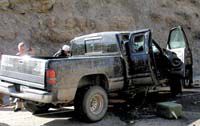| The truck driven by Alana Thompson just following a three vehicle collision on U.S. Highway 6 on Friday. |
The driver of the pickup truck involved in a crash that shut down U.S. Highway 6, for several hours last Friday is in stable but serious condition at University of Utah Medical Center, according the Joan Stout, the driver’s mother.
Alana C. Thompson, 29, of Price, reportedly crossed the center line in a black Dodge truck, according to Utah Highway Patrol Sgt. John Kelly. The sergeant added that upon crossing the center line Thompson purportedly hit the left rear trailer of a white Ford flatbed pickup at mile marker 226. The white Ford driven by 64-year-old Murray Robertson of Highland had only minor involvement in the accident.
“Thompson then continued across the center and hit head-on into a Haycock Petroleum truck,” said Kelly. “She was not wearing her seatbelt and was airlifted from the scene to the University of Utah Medical Center in Salt Lake City. As of Sunday afternoon Thompson was is serious but stable condition”
According to Kelly, the investigation is still open as to why Thompson crossed the center line. He did however report that any drug or alcohol involvement has been ruled out.
“The two-year-old riding with her, McKayla Thompson, was properly strapped into her car seat and was treated and released at Castleview Hospital with only minor scrapes and bruises,” said Kelly. “I can’t stress how important proper safety restraint is for children, what a difference it makes.”
The potential for danger from fuel resting within the Haycock Petroleum tanker truck played a factor in the amount of time the road was closed but according to Kelly the truck’s tank was never compromised during the accident and no fuel was released from the container.
While no fatalities occurred during the recent accident U.S. Highway 6 is notorious among those who drive the canyon road.
A report given by the KSL news website stipulated that historical statistics demonstrated that in the mid 1990s fatal accidents were three times more likely in Spanish Fork Canyon than in Big Cottonwood or Parley’s canyons, and five times more likely than in Little Cottonwood, Sardine or Ogden canyons.”
| The twisted remains of the truck that collided head-on with a black Dodge truck along U.S. Highway 6. |
The Utah Department of Transportation also confirms that areas of Spanish Fork Canyon are especially dangerous, specifically the red narrows portion near Spanish Fork. The department has recently installed speed monitoring signs that alert motorists of their current speed and the speed at which they should approach certain oncoming turns. However, according to department officials such devices are only effective if drivers heed their warning and slow down.
The big question asked within the KSL news website report was this, how does the state make the winding canyon road safe for more than a reported 18,000 vehicles per day?
UDOT continues to make improvements, widening the road in sections and increasing passing lanes but during the calendar year 2007 there have been 278 vehicle fatalities, 30 in the month of September. However, only a small fraction of those have occurred along U.S. 6.
The department conducted an environmental impact study following a semi truck roll over and subsequent explosion in the late summer of 2005. But most police officers and transportation engineers have similar statements concerning the road.
“Highway 6 is dangerous, always has been and most likely always will be,” said Sgt. Kelly. “Safety along that road comes down to the way it is driven, an individual can minimize the risk they take if they would just slow down and take the road as it comes. Trying to make up time along U.S. Highway 6 could be the biggest mistake of a person’s life.”
Sgt. Kelly wanted to commend the Carbon County Ambulance Service, Helper Rescue 3 and Helper’s Fire Department for their work in what he described as a very difficult extrication.
“We are lucky to have such a good team of emergency personnel working in our community,” said Kelly.

